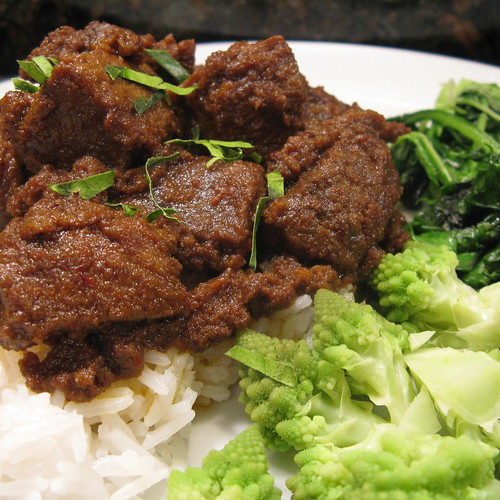
I was a little worried about finding some of the ingredients for this curry but luckily our hosts, Rayrena & Belita had done a lot of background work for us & gave us easy substitutions. I actually only had to substitute a few things since my grocery store was pretty darn good & had fresh lemon grass & kaffir lime leaves in the herb section.
We really enjoyed the smell of this dish cooking & the way it tasted at the end. We've never had a dry curry before so it was interesting to have something that wasn't as saucy as We're used to. I used 2 fresno chiles in ours & still found it quite hot, Matt thought it had no heat at all (I'm such a wimp). I think we will make this again as its a nice change from our usual chicken curry.
Beef Rendang (Rendang Daging Sapi)
Excerpted from Cradle of Flavor: Home Cooking from the Spice Islands of Indonesia, Malaysia, and Singapore by James Oseland (W. W. Norton & Company, Inc., 2006) Copyright 2006 by James Oseland.
Makes 4 to 6 servings
For the Flavoring Paste:
* 1 whole nutmeg, cracked open with a nutcracker or a heavy, blunt object such as the bottom of a glass measuring cup
* 5 whole cloves
* 6 shallots (about 5 ounces), coarsely chopped
* 3 cloves garlic, coarsely chopped
* 5 to 20 fresh red Holland chiles or other fresh long, red chiles such as Fresno or cayenne, stemmed and coarsely chopped
* 1 piece fresh or thawed, frozen turmeric, 2 inches long, peeled and coarsely chopped (about 2 teaspoons), or 1 1/2 teaspoons ground turmeric
* 1 piece fresh ginger, 2 inches long, peeled and thinly sliced against the grain (about 2 tablespoons)
* 1 piece fresh or thawed, frozen galangal, 2 inches long, peeled and thinly sliced against the grain (about 2 tablespoons; optional) regular ginger may be substituted (I just left this out)
* 5 candlenuts or unsalted macadamia nuts (I used almonds instead & they worked just fine)
For the remainder of the dish
* 2 pounds well-marbled boneless beef chuck or bottom round, cut into 2- to 2 1/2-inch cubes
* 2 1/2 cups unsweetened coconut milk
* 3 thick stalks fresh lemongrass, each tied into a knot
* 1 piece cinnamon stick, 4 inches long
* 7 whole fresh or thawed, frozen kaffir lime leaves
* 5 whole daun salam leaves (optional) OR curry leaves OR bay leaves (I used bay leaves)
* 1 teaspoon kosher salt
* 1 tablespoon very finely shredded fresh or thawed, frozen kaffir lime leaves (optional) OR lime zest (One tablespoon of zest from a lime is equivalent to about 6 kaffir lime leaves.)
1. To make the flavoring paste, place the nutmeg and cloves in a small food processor and pulse until ground to a dusty powder, about 2 minutes. (This will dye the bowl of your food processor yellow!)
2. Add the shallots, garlic, chiles, turmeric, ginger, galangal (if using), and candlenuts to the ground spices. Pulse until you have a chunky-smooth paste the consistency of cooked oatmeal.
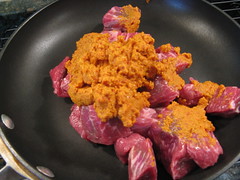
3. In a 12-inch skillet (nonstick works best), mix the beef and the flavoring paste until well combined. Add the coconut milk, lemongrass, cinnamon, whole lime leaves, daun salam leaves (if using), and salt. Stir well to combine and bring to a gentle boil over medium heat. Immediately reduce the heat to medium-low and simmer uncovered at a slow, steady bubble, stirring every 10 to 20 minutes with a spatula to prevent the meat and coconut milk from sticking and scorching. You'll probably need to adjust the heat periodically to maintain an even simmer.
4. The meat, coconut milk, and flavoring paste will now go on a fascinating journey. At first, the broth will be thin and gorgeously bright orange. As it cooks, the coconut milk will reduce, its fats (as well as the fat the meat renders) separating from the solids. It will become progressively thicker and darker, eventually turning brown.
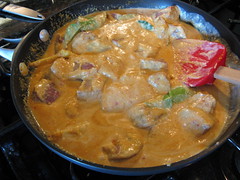
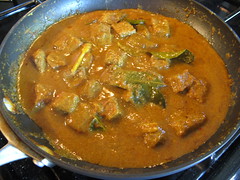
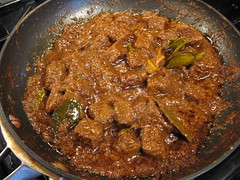
Continue to simmer gently until the liquid has reduced by about 95 percent, stirring every 15 minutes or so to prevent sticking. Only the meat, oils, and a bit of very thick sauce will remain in the pot. This will take anywhere from 2 to 3 hours, depending on the skillet that you use, how hot the fire is, and the richness of the coconut milk. Test the meat; it should be tender enough to poke easily with a fork. (Like one of our hosts I found my sauce was dry before my meat was tender so I added a cup of chicken broth & let it continue cooking down.) Taste some of the liquid for salt, and add a pinch more if needed.
5. When all the liquid has evaporated, reduce the heat to low (the meat and the remaining sauce are prone to burning) and allow the beef to brown slowly in the rendered fat. (The fat may be foamy at this point, but it will settle down when the cooking stops.) Stir every 5 minutes or so to prevent sticking and scorching, being careful not to break the beef apart. Continue sautéing the beef until it's the color of roasted coffee beans, 5 to 10 minutes longer. The surface of the beef should be barely moist and have an appetizing oily sheen. (If there is too much oil in the pan for your liking, skim some of it off with a spoon and set aside for later use; it's wonderful for sautéing potatoes.)
6. Remove and discard the cinnamon, lemongrass, lime leaves, and daun salam leaves (if used), and then transfer the beef to a serving dish. (Alternatively, serve this dish with all the aromatics, for a more rustic presentation.) Garnish with the shredded lime leaves, if using. Allow the beef to rest for at least 30 minutes before serving. Slightly warm room temperature will best show off its intensely aromatic flavors. This dish will taste even better the next day.
Visit Recipes to Rival for more cooking nots on this recipe.
Love how this dish seems nice and spicy. Great soup also.
ReplyDeleteThat looks fabulous. I made the potato version, but next time I'm going to make the beef for my husband.
ReplyDeleteKat, I grew up eating this dish and yours looks pretty authentic! :) I've only made it from a paste b/c I've been too intimidated by the ingredients. I look forward to trying it with the substitutions! Thanks!
ReplyDeleteMy sister recommends NOT substituting bay leaf for the daun salam. If you can't find the daun salam (and it's readily available online for cheap), then it's preferable to do without.
ReplyDeleteI've always wanted to make beef rendang: it's that paste-making that kinda throws me off. Great-looking beef rendang!
ReplyDeletelooks great even if it was a little spicy.
ReplyDeleteThat looks absolutely beautiful! I like dry curries for a change sometimes. And I am so pleased you posted all those substitutions because there is no way I would be able to find the original ingredients!
ReplyDeleteYour rendang looks really good. Great job! Mine turned out too spicy too & I love spicy food. I will totally be making this again, though with less chiles.
ReplyDeletegreat pic! I loved trying the dry curry, too!
ReplyDeleteYours looks amazing Kat. So funny I use to think I didnt like curry but that was before I realized that curry is more of a blend, a sauce. I use to think curry was the stuff that came in powder form from the grocery store. (never liked that) But I am so glad I gave curry a chance.
ReplyDeleteOh your pictures look great! For the ingredients I couldn't find, I just left them out. But I now find that I'm constantly looking for them for future tries at this recipe. Glad you enjoyed it and that I wasn't the only one who had to add stock during cooking. Great job!
ReplyDeleteLuv the spices used here...the aroma from the kitchen must have been intoxicating. The pic is none too shabby either!
ReplyDeleteIt looks like your texture turned out just right but I've got to agree with Desert Songbird's sister that those substitutions changing the flavor profile quite a bit. So long as you're happy with how the dish tasted certainly you can do what you wish, just know you aren't getting the full Indonesian experience. Personally, I find those alien yet accessible flavors my favorite part of Indonesian cooking and it's a shame to miss them.
ReplyDeleteI love the step by step photo's and the end result looks fabulous. I suffer from a yellow food processor bowl now too. But I think it was worth it. Great job
ReplyDeleteYou and Matt are opposite of Josh and I - I like it spicy, but he doesn't!
ReplyDeleteZach is actually taking Indonesian language classes now so I think that he should make this for us soon.
ReplyDeleteHmmm - I absolutely love rendang. There is an amazing Indonesian resto in London - I have to have it there every time I go!!
ReplyDelete